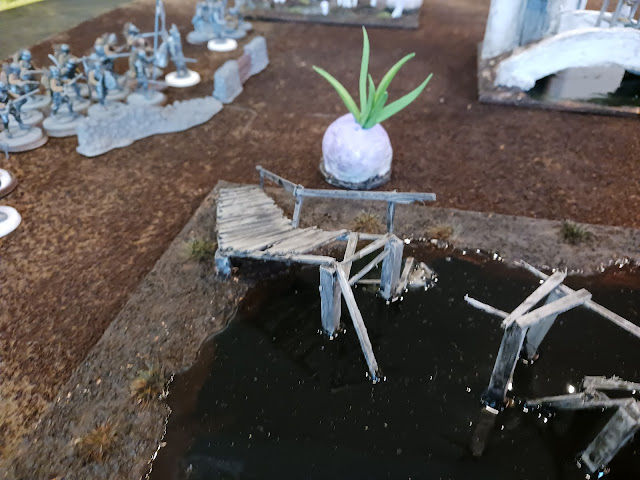Managed to arrange for a game of Turnip28 quite quickly after finishing my terrain set! Ben's regiment is only partially painted but he completely restarted the project with new conversions. He suggested just starting the campaign from the Taster book. He took the Tall Man cult and I took Grand Boombard.
I previously played Ben back in February or so (no photos) and a new version (v17) of the rules had come out since. So there was a lot of rule looking up. Luckily, the tri-fold QRS that is now available is super helpful and a lifesaver.
In the Taster-version of the Long March there are five objectives, one basically in each quarter of the board and one in the middle. We were both able to claim the two in our halves and Ben got to the center one first.
The next turn was just sort of back and forth. There was a biggish melee on my left, and I ended up losing my objective marker over there. The Grand Bombard kept firing but not hitting anything.
At some point at maybe turn 3 I realized the utility of the Grand Bombard cult's ability to have Toffs and Toadies (commanders) seize objectives - every objective I had added +1 to the Bombard's to hit roll. At the beginning of the fourth and final turn I was able to momentarily capture 3 of the 5 objectives. +3 to hit! But the Bombard rolled a one and since it already had 3 panic tokens (making it "unstable" as an artillery piece) the whole thing exploded.
Ben was then able to fairly easily recapture some of the objectives since they were defended by a solitary individual, and he picked up the win.
 |
| Appropriately, this piece of dangerous terrain was responsible for consuming many figures! |
This was only the second time I've played Turnip28 this year so I wasted a lot of game time looking stuff up. In theory we will link our future games together using the system proposed in the Taster book.
Up next? I need to finish my fourth and final piece of dangerous terrain its about 50% done), and I need to make some obstacle pieces (crumbling walls, waddle fences, etc.). I need to make tokens to denote which objective is currently in control of whom. I need to make/convert a stump gun (i.e. a regular artillery piece) to go with the Bombard. I have the pieces to create some cavalry and a procession of woe cult, so I should do that sometime soonish.





























